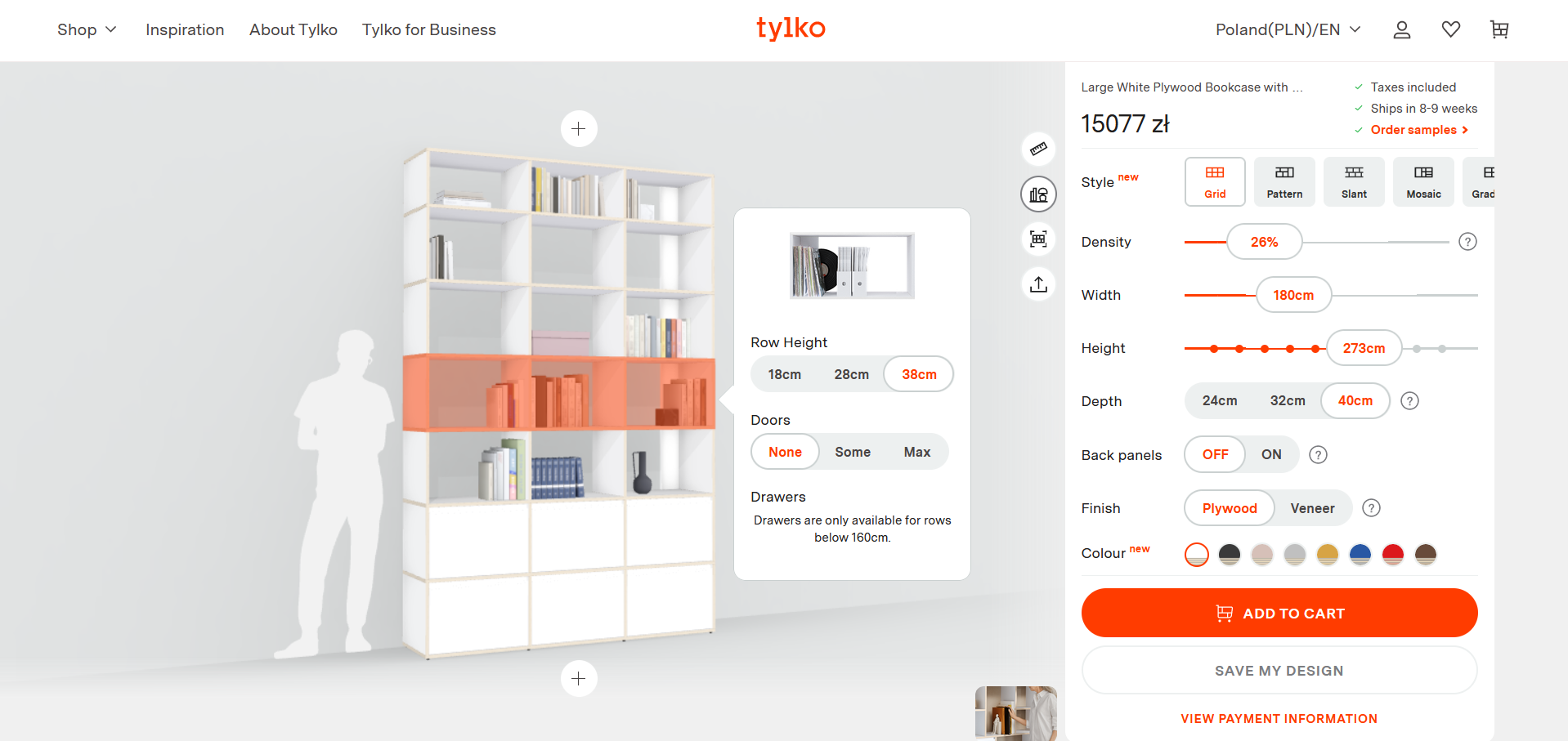How Headless Architecture is Changing the Game of Furniture Industry?
By Karolina Jakubowicz
By Karolina Jakubowicz

The Headless approach to online business is not just a trend but a game-changer, especially in the challenging and competitive realm of the furniture industry. Selling furniture online poses unique challenges compared to traditional stores, making the adoption of this technology even more crucial for overcoming these obstacles.
From enhanced performance to addressing longstanding challenges, I'll explain how this architectural shift is steering the furniture industry toward a more adaptable and customer-centric future. Let's see how Headless Architecture is shaking things up in the world of furniture!
Let's first answer the question - Why do traditional solutions fall short?
Traditional eCommerce solutions often come with limitations. They make it hard to come up with new ideas and adjust to changes in the market. The inflexible setup of big, all-in-one systems can make it tough for furniture stores to grow as customers' needs change. Going headless solves these issues by offering a flexible and easy-to-change structure.
Headless architecture is not some fancy buzzword. It's actually a modern approach to building websites and applications that separates the frontend (the "head") from the backend (the "body"). In simpler terms, it's all about decoupling the presentation layer from the business logic layer. It provides more freedom in designing the user interface and adapting it to various sales channels.
You can learn more about the tech side of the headless approach in our other article - Understanding Headless eCommerce - Glossary of Terms and Concepts.
Did you know that even a one-second delay directly correlates with a 7% decrease in conversion rates (Source)? People value their time, so they expect websites to function rapidly, displaying products and offers almost instantly. This is why, having a fast website builds trust in the eyes of customers.
By separating the presentation layer from the underlying infrastructure, headless architecture enables faster delivery of content to customers. The streamlined process allows for optimal performance as only relevant data is sent between server and client, minimizing unnecessary data transfers. Also, hosting the frontend using a CDN enables rapid loading of the website globally, ensuring consistent speed across the world.
This results in faster loading speeds, better customer experience and positively impacting conversion rates.
Gone are the days when furniture brands had to rely on monolithic systems that were difficult to update and customize. With headless architecture, furniture ecommerce can easily make changes to their website's design and functionality without disrupting the underlying infrastructure.
This means that they can quickly adapt to changing customer preferences and market trends, ensuring that their online presence remains fresh and engaging. Need flexibility in design, add a new feature, or integrate with a third-party service? No problem! Headless technology enhances user experiences, making online furniture shopping easier and more engaging!
In the age of omnichannel experience, furniture companies need to provide a consistent experience across multiple platforms and devices. Headless architecture enables seamless integration with different platforms, such as mobile apps, social media, and virtual reality. This means that customers can browse and purchase furniture wherever and whenever they want, without any hiccups.
Nobody wants to wrestle with a clunky website or get lost in a maze of confusing menus. Headless architecture enables furniture companies to create clean and intuitive user interfaces that make browsing and purchasing a breeze. From easy navigation to seamless checkout processes, customers can enjoy a frictionless experience that will make them love your furniture even more. Who knew buying a couch could be so smooth?
Headless architecture enables furniture companies to gather customer data and provide personalized recommendations based on individual preferences. By analyzing customer behavior and purchase history, companies can offer targeted marketing campaigns that resonate with customers on a personal level. Say goodbye to generic ads and hello to personalized online experience that actually make you go, "Oh, this is exactly what I need!"
One size does not fit all when it comes to furniture. Customers have different preferences, styles, and spaces to furnish. Headless architecture empowers furniture companies to offer enhanced customization options, allowing customers to personalize their furniture choices.
Headless technology allows eCommerce businesses to introduce virtual room planning, augmented reality (AR), 3D visualization, and other interactive elements to contribute to a more engaging and satisfying shopping journey. This immersive experience allows customers to make informed decisions, reducing uncertainties associated with online furniture purchases.
Whether it's selecting the fabric, color, or size, headless architecture makes it easier to cater to individual needs and create a truly unique shopping experience.
Let's face it, we're all glued to our phones these days. Headless architecture allows online furniture brands to optimize their websites and applications for mobile devices, ensuring a smooth and user-friendly experience. Furthermore, with cross-platform compatibility, customers can seamlessly switch between devices without losing their shopping progress.
Keeping track of inventory can be a headache, especially for furniture companies with a vast catalog of products. Headless architecture streamlines inventory management, syncing real-time inventory data across various platforms. This means fewer instances of that dreaded "out of stock" message and happier customers who can always find what they're looking for.
With headless architecture, order processing, and fulfillment become a well-oiled machine. From order placement to shipment tracking, the entire process is optimized for efficiency and accuracy. Furniture companies can integrate their systems with logistics partners and provide customers with real-time updates, enabling a smooth and hassle-free delivery experience.
Keeping your website up-to-date with the latest product information, promotions, and blog posts can be a daunting task. However, with headless architecture, content management becomes a piece of cake. Online stores can easily update content across multiple platforms, ensuring that customers always have access to accurate and relevant information. Plus, the ability to quickly make changes means that furniture companies can adapt to market trends and stay on top of their game.
Going headless can bring about technical complexities and integration challenges for furniture ecommerce. As headless systems rely on APIs and microservices, businesses need to ensure seamless integration between various platforms and systems. This requires careful planning to avoid potential issues and maintain a smooth workflow.
Adopting headless architecture may require furniture businesses to upskill their staff or hire new talent with expertise in working with API-driven systems and microservices. Training employees to understand and navigate the complexities of headless architecture is crucial to fully leverage its benefits. Investing in training programs or hiring experienced professionals can help businesses overcome this challenge.
With the increased use of APIs and third-party integrations in headless architecture, furniture businesses need to address data integration, security, and privacy concerns. Since data is transmitted between different platforms and systems, it becomes essential to implement robust security measures to protect customer information and comply with data protection regulations. Businesses must prioritize data encryption, authentication protocols, and regular security audits to maintain customer trust.
Picture this: you're determined to embrace the headless revolution, breaking free from traditional monolithic systems. But just like finding out you've misplaced a crucial screw halfway through construction, mishaps can and will occur without proper planning. This means meticulously strategizing every step of the transition, from choosing an API-first CMS to seamlessly integrating front-end and back-end technologies. And don't forget about testing!
You can learn step by step how to transition smoothly from our article - The ways and the process of migrating to headless eCommerce.

Tylko is a Polish furniture brand, where everything is produced locally, made only for your order. As they declare - "Our mission is to create harmony in every home – whatever your style, space or needs. Use our technology to customise perfect-fit furniture you’ll keep forever."
Their approach to the customer was used to create a product configurator that allows you to tailor the furniture to your needs. In addition, after its design, the customer immediately receives information about the price and delivery time. This innovative solution results in greater customer shopping awareness, loyalty to the store, and an increase in the conversion rate.
With their unique approach, they have successfully adopted headless eCommerce, which has allowed them to overcome many of the limitations. Tylko has gained full control over the customer experience without compromising on performance. Whether it's customizing furniture designs in real-time or effortlessly managing inventory across multiple channels, Tylko's headless approach has proved to be a game-changer.
Thanks to this innovative strategy, they are now able to provide a highly responsive and engaging online shopping experience for their customers that's tailor-made to fit their preferences.
Impressed yet? You should be!
Looking ahead, there are exciting developments anticipated in the realm of Headless Commerce. As technology continues to advance, we can expect further enhancements and innovations in how this approach shapes the digital commerce landscape.
Headless Commerce is likely to integrate more seamlessly with emerging technologies such as augmented reality (AR) and virtual reality (VR). This integration can elevate the online shopping experience, particularly for industries like furniture, by allowing customers to virtually visualize products in their own spaces.
Anticipate the integration of more robust artificial intelligence (AI) and machine learning (ML) capabilities within Headless Commerce systems. This development can lead to more sophisticated personalization, recommendation engines, and predictive analytics, offering a highly tailored and intuitive shopping experience.
Application Programming Interfaces (APIs) play a central role in Headless Commerce. Expect the ongoing evolution and standardization of APIs, facilitating smoother integrations, interoperability, and compatibility with third-party applications.
Content management is a critical aspect of Headless Commerce. Anticipate the expansion of Headless Content Management System (CMS) solutions, offering more flexibility and ease of content creation, management, and delivery across various channels.
Because a lot of Headless Commerce solutions are open-source, we expect more people to work together on making improvements. This teamwork can bring in a variety of new features and upgrades, making the whole system better for everyone involved.
Headless Commerce is a game-changer for the furniture industry, offering unparalleled flexibility, scalability, and the ability to deliver exceptional user experiences.
By adopting a headless approach, furniture companies can focus on creating engaging user experiences while leaving infrastructure management to specialized providers. This not only saves time and resources but also ensures seamless scalability as businesses grow.
While there may be challenges and considerations to overcome during implementation, the real-life success stories serve as inspiration and proof of its transformative potential.
Anticipated developments include integration with emerging technologies, enhanced AI capabilities, evolving API standards, and community-driven development.
But how to implement maintenance mode in Next.js? Is it as easy as configuring a plugin on WordPress for a few minutes? Of course it is!
Magento, compared to Medusa, may lead to higher long-term costs due to its licensing model and the risk associated with the gradual decline in the popularity of the PHP language...